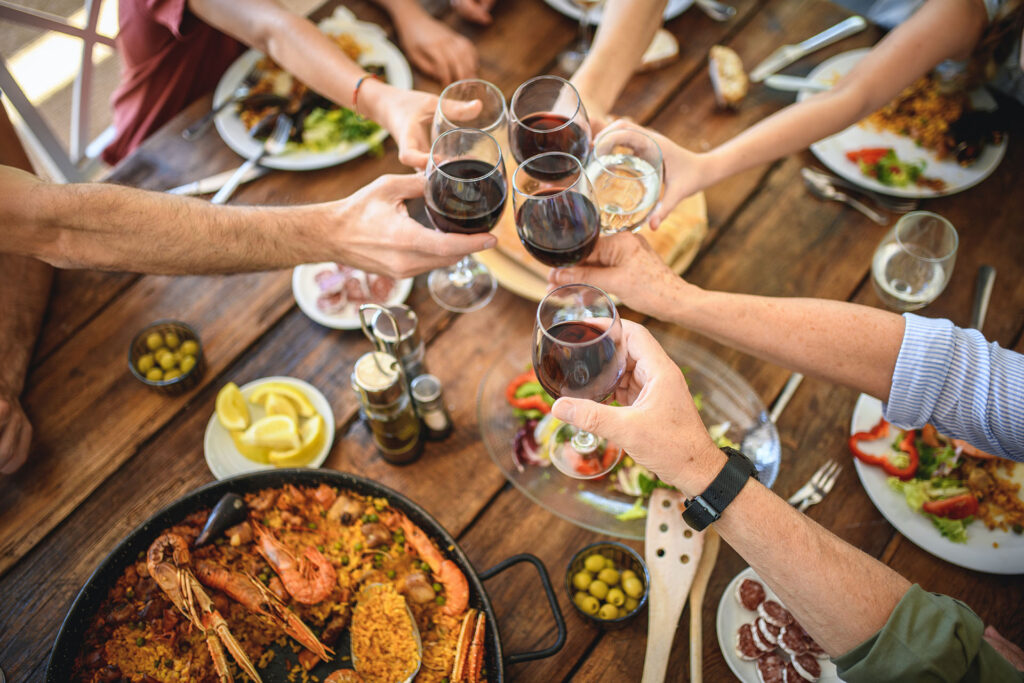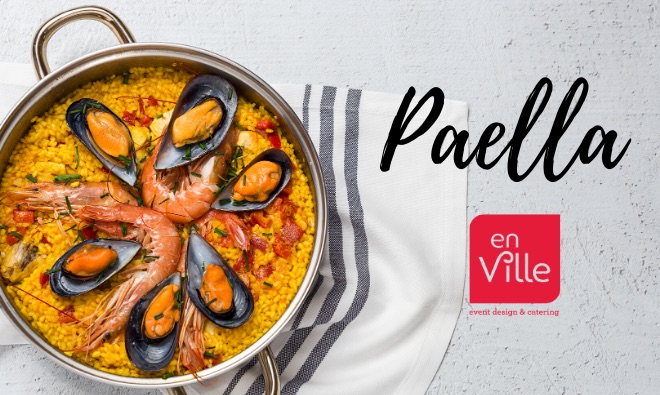
An Introduction to Arroz con Cosas (aka Paella)
By Andrew Bowden, en Ville Catering
This article isn’t about the history of paella, but it does reveal the most important thing about Spain’s exalted, luxurious, contribution to the culinary world.
Before getting to the most important thing, here’s an important morsel of the dish’s somewhat more humble history. Paella originated in Valencia (the region, not the city) as a simple lunchtime staple of farmers and labourers working in the fields. Spain already had rice (it had been introduced by the Moors), and it had become a cheap staple.
Hungry workers would gather local ingredients that were inexpensive or free, and abundant, in and around the rice fields, and toss them into a paella (which, confusingly, is the name of the actual cooking pan itself, in the Valencian dialect, and also the name of the finished dish), along with rice, and cook it over wood like pine, and orange branches and pinecones that could be gathered nearby, infusing the rice with smoky deliciousness. These ingredients were always the same (and in Valencia, anyway, still are), and included rabbit, voles, snails or duck, along with butter beans. As a special treat, artichoke hearts were included when in season. The rice would absorb the smokiness of the pinecones and fragrant orangewood, infusing it with another layer of flavour.
Ask a modern Valencian what goes into paella, and the answer will always be the same, unchanged for centuries. Ask any other Spaniard, and you’ll get a grocery list including opulent ingredients like saffron and shellfish, as well as chorizo, and different types of vegetables and meats.

Valencians don’t object to regional variations of the dish, they do object to it being called ‘paella’, however! In Valencia, they have a name for paella-adjacent, not rabbit, bean and snail containing rice dishes: ‘arroz con cosas’, rice with things. This gets a little closer to the most important thing bout paella. Rice with things.
The recipe changes from region to region in Spain, using what’s produced locally, what’s available seasonally. Even the variety of rice changes. In Catalonia they include squid ink, all over Spain different types of seafood and fish are used, depending on what is around. Even in the Philippines, ‘arros a la valenciana’ or ‘paelya’ is made with locally grown glutinous rice, and longanisa sausage.
What remains the same every time paella is made, however, is that it’s slowly cooked in a wide, shallow pan. The whole preparation is never deeper than a little finger. This is important for a couple of reasons. First, each bite gets some of the good stuff, you’re never left with a deep layer of plain rice. Second, and most importantly, it allows for the formation of the golden brown, crispy crunchy layer of rice to form at the bottom. Your rice isn’t burnt! This is the ‘socarrat’, the rice crust. This isn’t unique to Spain, almost every rice eating culinary tradition has a dish, or dishes, that strive for the perfect rice crust in the bottom of the pot. Look at the Persian tahchin, for instance. Perhaps the best example of rice crust in any cuisine!
The concept of paella is an ideal way to highlight local, seasonal produce. Rice as a foundation, supports a list of ingredients that tell a story if the flavours of here. Or there. Or wherever. A carefully constructed and thought out paella, including meat, seafood, vegetables and even a local variety of rice, can tell an almost complete story of local and seasonal flavours.

The trick here is not to be bound by one recipe for bomba rice, saffron, mussels, shrimp and broad beans. Learn the concept of making a paella. Go to the market, buy a box of vegetables, buy some meat, fish or seafood, and don’t be intimidated. Everyone can cook rice, right?!
Really, if you can learn how to craft a basic paella, you can substitute and play with ingredients to build a locally inspired dish. Watch a video, learn a basic technique. For something really special, try cooking it the original way, the next time you’re camping, or up at the cottage, where you have a fire pit. Cook it over the open fire. Use the wood from around you.
It’s Springtime, early Summer, use some asparagus, fiddleheads, garlic shoots. Do you know someone who hunts? Do you hunt? Think about wild turkey, venison, game birds. What about local mushrooms. Morels will be up before you know it!
Could it be that we’ve just stumbled across the perfect Ontario paella? Local asparagus, woodland mushrooms, little wild onions, cooked over fallen birch and maple branches? How about this: mix in ten or twenty percent Canadian wild rice – it’ll add some nutty layers to the flavour, and a great texture too! Think of all the regional flavours that you could use on the East or West coasts. Are you adding some wine to deglaze? It goes without saying that a local variety would work best!
Maybe paella is more of a national concept to Spain, than a national dish. We already know that the recipe and ingredients change depending on where you go. One thing that doesn’t change, however, is that it’s never paella for one. Paella pans range in size from pretty big to so-big-you’d-be lucky-to-fit-it-on-your-stove (These ones are best for the fire pit). That means, unless you plan to eat leftover paella every day for a week (okay, not the end of the world), you’re making paella for a group!
Paella is something that is always shared. It’s a dish that’s always surrounded by joy, by companionship, love, and meaning. It’s about who you’re eating it with, what you’re bonding over (maybe you’re bonding over the local flavours of here and now!).
Further evidence, then, of paella as a national concept. It’s a simple dish, full of flavour, representative of the season, shared by a group. Look no further than the lunch culture of Spain! Long, leisurely meals, shared with friends and family, all eating from the same pan, enjoying wine, all followed by a siesta.
Nevermind the protesting Valencians in the back – okay, okay, it’s arroz con cosas, not ‘paella’. But the important concept here, is the things. Rice with things. What are the things? The flavours of here and now, the people you’re sharing it with, the time you’re taking to make it, and think about how it’s constructed, what you’re talking about, what you’re drinking with it, what you’re celebrating, and what you’re remembering.
Maybe it’s even better to think about paella as rice with things. But not in the way Valencians pejoratively mean ‘things’, but ‘things’ as in everything that goes with making and enjoying it. That’s the most important thing about paella.

We encourage you to experiment with this! Watch the video embedded here, learn the technique, then forget about the ingredient list and make it your own!
_________________
en Ville was founded in 1982 by Geoffrey Johnson, a classically-trained chef whose dream was to unite his passion for great food and his love for entertaining in order to create memorable and distinct events and parties. Now, more than thirty years later, en Ville has become one of the premier catering companies in Toronto by consistently exceeding expectations and fulfilling the dreams of hundreds of clients. www.enville.com

